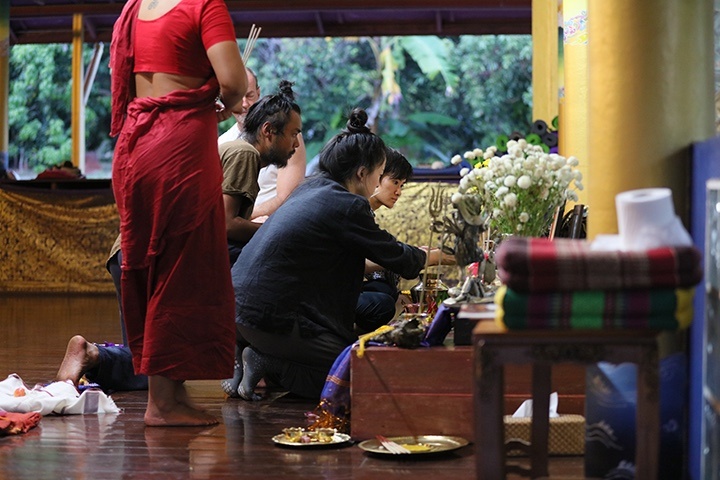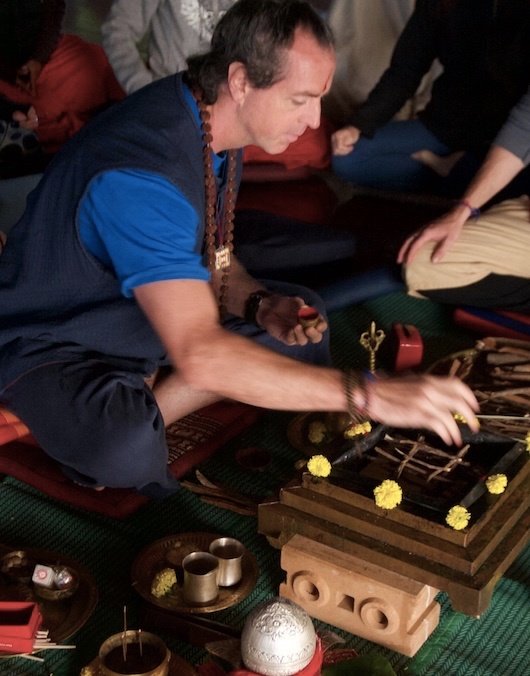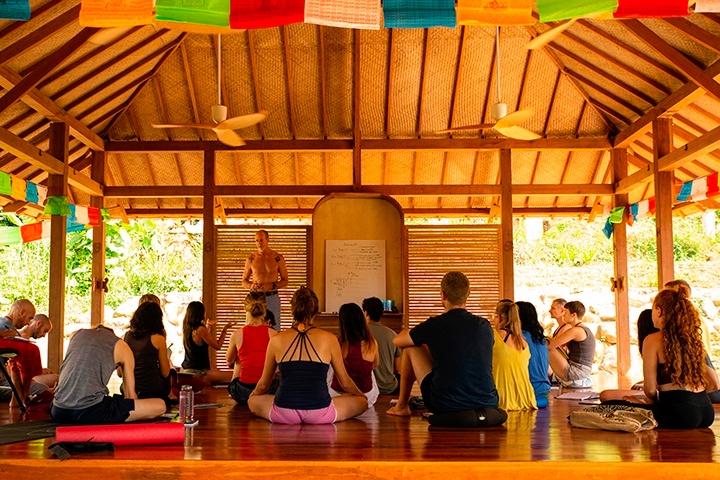WAY OF WATER
LEVEL I
TANTRIK PŪJĀ TRAINING:
Beginner, Intermediate, Advanced
Jan. 15th – Feb. 25th, 2023 | Uvita, Costa Rica
It is our sincere desire that students of nondual dharma traditions be able to learn the breadth of the pūjā tradition from a supreme master of Pūjā.

WAY OF WATER
Path Overview
WHAT IS THE WAY OF WATER?
Multi-Faceted Approach
Way of Water practice combines the components described below into one cohesive path of practice. For example, in the practice of Deity Yoga wherein the practitioner uses elements of Tantrik Ritual, Kriya Yoga, and Guru Yoga, embedded within a matrix of Virtuous Conduct, Devotion, Compassion and cultivation of the Enlightened Bhava of the Deity.
The Main Virtues, Mode of Being & Attainment Cultivated in Way of Water
A Way of Water practitioner is someone who is attracted to developing and expressing the virtues of Love, Devotion, Compassion, Surrender, Humility, Acceptance and Non-Resistance as their main focus. They are Heart-Centered people who wish to practice a path of Beauty. The Way of Water practitioner is not as concerned with “when” they will become enlightened. They are more content to feel the fullness of the practice in each moment without rating their experience. They lack the “edgy” and fiery ambition natural to those practitioners of the Way of Fire and Way of Warrior. Love is its own type of Spiritual-Fire. It quickens realization of the Path and avoids the dangers of over-strenuous effort and pompous spiritual pride. The Way of Water practitioner walks the path of beauty and humility.
In summation, the Way of Water is the Way of Love & Devotion. Life is lived as a Compassionate Intent, and this is its own reward.
THE MAIN COMPONENTS OF WAY OF WATER:
-
Tantrik Ritual:
Learning and performing Puja (water based ritual) and Homa or Yajna (fire based ritual) for your deity, and for performing compassionate actions such as giving blessings of long life, removing obstacles to the path or blessing a new home, etc.
-
Deity Yoga:
Outer, Inner and Secret modes of unification with your Deity’s Essence, thus awakening you to your own enlightened condition.
-
Kriya Yoga:
Working in the subtle energy system of nadis, cakras, and bindus in order to transform all karmic conditioning and limitation of body, speech and mind. This then allows for the possibility to act spontaneously and express your enlightened Personality Display.
-
Virtuous Conduct and Bhava Cultivation:
Learning to rest in the bhava of Devotion, Compassion & Surrender. This transforms all of one’s actions into virtuous conduct beneficial to all. This is accomplished via Kriya Yoga practice and invoking and abiding in the enlightened mandala of your deity as the central focus of Deity Yoga.
-
Guru Yoga:
Realizing one’s Nature in the Polished Mirror of the Guru’s Essence. Outer, Inner, and Secret modes of unification with one’s own Nature catalyzed by the Guru’s Awakened State of Being through transmission.
WAY OF WATER HAS THREE LEVELS:
Level I - Tantrik Pūjā (Beginner, Intermediate, & Advanced)
Jan 15th- Feb 25th, 2023
Scroll below for more details.
Level II - Daśamahavidyā Teachings, abhiśekam, sādhanas + Rudrānanda Kriya Yoga
October 2nd- 15th, 2023
*Students can attend the Way of Water - Level II without completing Level I.
Click Here to view details for Level II.
Level III - Śri Vidya Puja & Maithuna Sadhana. Direct Realization Teachings and Practices.
Dates to be Announced
*By application only after completing Way of Water – Level II.
WAY OF WATER -Level I
Retreat Details
What is Pūjā?
In Level One of the Way of Water, you will learn the ancient Tantrik practice of Pūjā. Pūjā is the Sanskrit word for ritual or ceremony, and is also defined as “worship”. However, the English word “worship” may be misleading here because Trika Mahāsiddha Yoga does not have in its View Teachings any “Supreme God or divinity” who is the Creator, or who is superior to our own Essence, that we bow down to, or upon whom we are dependent for our “salvation”/liberation.
How does it work?
Rather, in the performance of esotericized Tantrik Pūjā, the practitioner brings forth the deity from their own continuum of consciousness-energy and into our world of form and desire, thus manifesting their power and wisdom in the various receptacle components of the ritual – the vase of water, the fire, the yantra, the mercury linga, the śrī cakra, the painting, the statue, etc. This gives the practitioner a focal point upon which to concentrate in order to more effectively contact and engage with the formless subtle body of the deity. Through the art and science of Pūjā the unmanifest is made temporarily manifest for our benefit. This is what makes pūjā so effective for awakening our inherent, but dormant capacity for unlimited Compassion, Wisdom and Self-Realization.
Pūjā Invokes the Pure Mandala
As ignorant beings we inhabit a world of mental-emotional pain and suffering. Beings who have become spiritually realized inhabit and generate a mandala (a world) beyond the effects of karma – a mandala or world of what is termed “Pure Vision” in Nondual Dharma. In the practice of pūjā we learn how to invoke the realized mandala of various forms of enlightened beings, how to bring it into our reality so that we can occupy such sublime realms in our moment-to-moment experience. Eventually we gain the realization that the mandala is generated by our own Essence Nature and that there is an indestructible link between ourselves and all of reality which we can now influence through our practice of pūjā. In this way we realize part of our Nature to be a dynamic connector or conduit for the seen and unseen, the temporal and that which is beyond time.
Pūjā is a Form of Dynamic Meditation.
Tantrik Pūjā is also a very efficient, beautiful and enjoyable way to attain fusion of the three centers of body, speech and mind, allowing the discursive mind and emotions to stop, so that we can relax into our True Nature. This makes Pūjā a meditation practice focused on the speech/energy & action/body aspects of our human nature, instead of merely using the mind alone as in the usual practice of meditation. In this way it is a unique form of meditation practice akin to Hatha Yoga and Warrior training that emphasizes devotion to Essence, and the union with, and expression of that sublime state through a dynamic practice. Also, because pūjā is a non-strenuous practice and it is so enjoyable, we look forward to our practice with great inspiration, delight and devotion - three key factors for success in sadhanas.

BEGINNER PŪJĀ
Jan 15 - 28, 2023
Fee: $500
At the end of Beginner Pūjā training the student will be able to masterfully perform the 16 offering pūjā of a deity, an Ātmā Pūjā and chant the liturgy and prayers involved in most Tantrik Pūjās.
*Preliminary: Review Pronunciation of Sanskrit. For this training students will only be responsible for being able to read Sanskrit in Roman letters with diacritical markings. Those students wishing to become either expert in ritual and/or an ācārya-in-training should strive over time to be able to read and write devanagari script.
-
Review of 16 Upacaras (standard offerings). This step will cover learning how to set up a proper basic 16 (or less) offering ritual and will teach proper offering techniques. mantras, etc.
-
Preliminaries. Ceremonies have certain preliminaries, which must be observed before the main body of the ritual proceeds.
-
Purification Ceremony. Purification of the space, the ritual instruments, offerings, the person performing the ritual, etc., must be completed to ensure the ritual will be efficacious.
-
Dhyana Ślokas: Learning to invoke the deities and gurus through their descriptive contemplation verses. These will include: Forms of Śiva (Bhairava, Mahākala, Śambhunātha, etc.) Guru Paramapara, Bhairavi, Ganeśa, Durga, Sarasvati, Hanuman, Kali, Lakshmi, Camunda…)
-
Pūjā practice. Putting #'s 1-4 all together now to practice the art of basic pūjā.
-
Atma Pūjā. Tantrik ritual of invoking the apparent individual self-form, the kshetrajña, as a pure and perfect emanation of the One Essence. An essential practice for Tantrik Yogins along with Agni Hotra taught in the Intermediate Pūjā course.
-
Abhishekhams & Practice. Practicing the ritual empowerment of a deity. This procedure is crucial to the practice of Deity Yoga, Tantrik Ritual and the Way of Water (Abhishekams of the Gateway Deities include: Ganesha, Sarasvati, Durga, Śambhunatha & Hanuman).
-
Universal Prayers. A collection of prayers used regularly in the rituals, such as the category of peace prayers, etc.
-
Stotras & Suktam. These are a category of longer prayers chanted in the rituals.
_______________________________________________________________
INTERMEDIATE PŪJĀ
Jan 29 - Feb 11, 2023
Fee: $500
-
Agni-Hotra. The daily practice for yogins to attune themselves to the cosmic cycles and open their spiritual Heart-Center. A core practice of the advanced levels of the Way of Fire when combined with Kriya Yoga (learned in Way of Water – Level II).
-
General Homa. The structure and procedure of a standard fire ceremony.
-
Navagraha Homa. Fire sacrifices to the 9 Planets to raise your awareness of your limiting karmic patterns. Through making ritual fire offerings combined with mantra and pure motive you can alleviate your karmic load and create lasting character change.
-
Vastu Homa. An important ceremony for consecration of any building, especially your home and practice place. It removes discursive energies and creates a flow of harmonious prānā throughout. This enhances the creativity, longevity, relationship harmony, safety and security of all inhabitants and guests.
-
Ayushya Homa. A ceremonial fire sacrifice that confers longevity through balancing the doshas' root causes as Tejas, Ojas and Prānā, and also clearing karmic obstacles to health and longevity. (*Note: we will also learn the standard Full Moon Healing Ritual as practiced monthly in the TMY online community.)
-
Gaya Śraddha. This is an important ceremony on the Tantrik ritual calendar. Performed every Fall season, offerings are made for all beings in the world who died from some type of tragedy such as fire, drowning, landslide, starvation, suffocation, murder, war, terrorist attacks, etc. In ancient times it was considered crucial to perform these types of rituals regularly to give an opportunity for liberation for those who may be in a state of torment after death. Performed regularly this ceremony is said to reduce the pressure of beings incarnating into the hell realms, which reduces their influence here on earth and in our minds.
_________________________________________________________________
ADVANCED PŪJĀ
Feb 12 - 25, 2023
Fee: $500
-
Dharma Partner Ritual. Finding a non-biased partner who is on the path, and who is able to reflect our limitations for us to see and correct is like a rare gem. In this ceremony we formalize a “life-long” commitment to each other’s realization “no matter what”. This ceremony is modeled after the Dharma Partnership ceremony enacted by Śrī Rama with Hanuman, his main devotee and friend.
-
Funeral for a Yogin. When the end comes we need to have our body and spirit handled in a way that is in accord with the way we lived, our View, our Practice and our Path. Performing this Yogin’s Funeral is a tremendous aid to the yogin in the after-death states. It gives strength, guidance, and the confidence to transition without faltering into a new higher rebirth or into total realization.
-
Exorcism Rituals. Ritual Exorcism can be understood as a form of spiritual hygiene. They are highly effective in re-establishing an unobstructed experience in the practitioner's life. Dharma Bodhi has used them in his practice as a health care practitioner and for students that have experienced temporary influence or partial possession through mistakes in conduct, etc.
-
Narayana Bali. This ceremony is important in a number of applications. For students of the Dharma it is used to rectify prānā disturbances in our life, mind and body caused by being born with all of the planets on one side of the astrological birth chart/earth.
-
Elaborate Rahu Appeasement Ritual. Yogins pay more attention to the placement of Rahu in their astrological birth chart than to most of the other malefic planets, because Rahu represents those karmas that we cannot see (think "Treasury of Worms"). In fact, when we are expressing Rahu’s negative karmic patterns of influence in our lives, we most often think that we are actually doing well, going in the right direction. Such is the deluding power of Rahu. This ceremony is a powerful way to raise our awareness of these hidden patterns and release or transform them.
PREREQUISITES
1. Completion of our 3-hour, Sanskrit Pronunciation Course. Students must be able to read Sanskrit in roman letters with diacritical markings to qualify for this training.
2. Optional: Completion of the Preliminaries of TMY (This will give a more comprehensive foundation from which to appreciate the path of the Way of Water within a Nondual tradition)
3. Beginner Pūjā is the pre-requisite for Intermediate Pūjā.
4. Intermediate Pūjā is the pre-requisite for Advanced Pūjā.
5. Students are required to bring their own Pūjā supplies. We won't be able to provide these items. Click to download the required SUPPLY LIST for the trainings.
WHO ARE THE TEACHERS?
The main teacher will be Śrī Rami Śivan of Australia. He will be assisted by Dharma Bodhi. This is a once in a lifetime opportunity to train with Dharma Bodhi’s main pūjā master – Śrī Rami Śivan, who is a Tantrācārya, Pūjācārya, and a holder of the Pañcaratra teachings and practices.
Śrī Rami-ji is one of the only westerners to ever have been empowered with this lineage. He is fluent in many ancient and modern languages such as - Sanskrit, Tamil, Hindi, Hebrew, and English. He is a veritable genius with a prodigious memory for the scriptures and a life dedicated to promoting the Dharma for the benefit of all beings. He is the author of many practice texts and translations, as well as having founded the Australian Council of Hindu Clergy. Śrī Rami has said that as he is getting up in age now, this will be the last time he will make the long journey from his temple-home in Sydney, Australia to our retreat center in Costa Rica. You will be so richly blessed to study with him.

As assistant teacher, Dharma Bodhi will teach the aspects of the practice directly related to the fusion of body, mind and speech, and how to apply pūjā practice to the generation and completion stages of deity yoga, kriyā yoga (Way of Water Level 2 topics), and meditation.

ACCOMMODATIONS & DAILY TRANSPORT
You will need to organize your own accommodation, transportation and meals during the retreat. Please check out these resources below to help plan your stay.
DAILY SCHEDULE
- MON - SAT (8am- 12pm): Teachings with Rami
- TUE, WED, & FRI (2-4pm): Teachings and Practice with Dharma Bodhi
- SUNDAYS: Rest Day
DATES & LOCATION
WAY OF WATER- Level I:
Beginner Pūjā : Jan 15th-28th, 2023
Intermediate Pūjā : Jan 29th - Feb 11th, 2023
Advanced Pūjā : Feb 12th - 25th, 2023
TMY Center | Uvita, Costa Rica
REGISTRATION FEE
Tantrik Pūjā - Beginner (only): $500
Tantrik Pūjā - Beginner & Intermediate : $1000
Tantrik Pūjā - Beginner, Intermediate, & Advanced : $1500
*meals, travel, & housing are not included.
CLICK TO READ OUR COVID TRAVEL POLICY
REGISTER BELOW
↓
Way of Water - Level I
Retreat
JAN. 15- FEB. 25, 2023 | COSTA RICA
REGISTRATION FORM
Submit the form below, and you will be directed to payment.
Full payment is needed to secure your place in the retreat.



